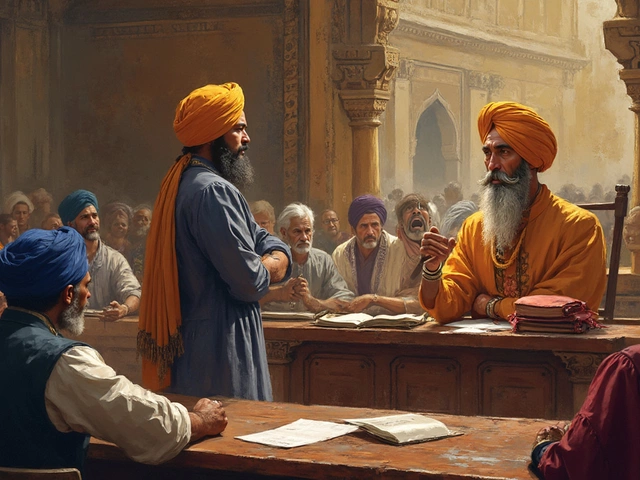The Kirpan isn't just a ceremonial dagger; it's a vital part of Sikh identity. Have you ever wondered why Sikhs carry this unique symbol? To understand its significance, we need to delve into its origins, back when Guru Gobind Singh, the tenth Sikh Guru, introduced it in 1699. It was a time when Sikhs needed to defend their faith and stand for justice, and the Kirpan was more than just a weapon—it was a symbol of courage and protection.
Fast forward to today, and the Kirpan continues to be an integral part of daily life for devout Sikhs. Wearing it serves as a constant reminder of a Sikh's duty to fight evil and uphold good. It's fascinating, isn't it, how something as simple as a small sword can hold such profound meaning?
But there's more to the Kirpan than meets the eye. It also involves a rich tapestry of cultural and legal narratives, especially in countries where Sikhs form a significant diaspora. Each place brings unique challenges and adaptations, shaping how the Kirpan is perceived and practiced. Stick around to explore how this sacred weapon transcends its physical form to represent an enduring spirit of justice and faith in the Sikh community.
- Origins and Historical Context
- Spiritual and Cultural Significance
- Legal and Social Aspects
- Modern-Day Relevance and Practice
Origins and Historical Context
The story of the Kirpan begins in the late 17th century, a defining moment for Sikhism under the leadership of Guru Gobind Singh. It's 1699, in Anandpur Sahib, when the Guru established the Khalsa, a community of baptized Sikhs, with the Kirpan as an essential emblem. This wasn't just any time; it was a period teeming with conflict and persecution. Sikhs needed a symbol to unite them and reaffirm their commitment to justice, honesty, and perseverance.
Historically, the Kirpan was much more than a weapon. Legends talk about its ability to inspire Sikhs with bravery and strength. The word 'Kirpan' breaks down into two parts: 'Kirpa,' meaning mercy, and 'Aan,' signifying honor or grace. So, the Kirpan embodies the dual concept of being merciful yet dignified.
The Role of the Kirpan in the Guru's Command
When Guru Gobind Singh introduced the Kirpan as part of the 'Five Ks'—articles of faith that baptized Sikhs are required to maintain—it wasn't just about defense. The Guru compelled Sikhs to use it responsibly, solely for protecting the oppressed and standing against injustice. This guidance is key to understanding why the Kirpan remains central in Sikhism.
The Kirpan has been chronicled in various historical texts, illustrating its dual role as both a spiritual object and a practical tool of resistance. Over centuries, historical records have shown how the Kirpan became woven into the very fabric of Sikh identity and community practices, often cited in stories of bravery and righteousness.
Its evolution is fascinating. What started as a defensive asset evolved into an enduring spiritual symbol. Fast forward to today, and it's not uncommon to still see it take center stage during Sikh ceremonies and processions, staying true to both the historical and spiritual context it has carried through ages.
Spiritual and Cultural Significance
The Kirpan isn't just an accessory; it's a constant reminder of a Sikh's commitment to their faith's core values. This symbolic dagger represents the warrior spirit within Sikhism, signifying bravery and self-defense. When Guru Gobind Singh introduced it, he intended it to be a symbol of a Sikh's duty to protect the innocent and uphold justice, aligning with the principles of righteousness and courage.
Every Sikh baptized into the Khalsa wears the Kirpan daily as one of the Five Ks. But have you ever considered why it remains significant? This small yet powerful item teaches Sikhs to stand against tyranny and help those in need. It's not about aggression; it's about maintaining peace and shielding the vulnerable.
Connection with Spiritual Identity
On a deeper level, the Kirpan carries spiritual meaning, reinforcing the wearer's dedication to Sikh virtues like compassion, honesty, and humility. By carrying the Kirpan, Sikhs declare their eternal readiness to challenge injustice and live with integrity, embodying the Gurus' teachings in everyday life.
Cultural Roots and Modern Symbolism
The Kirpan also plays a role in Sikh rituals and ceremonies. During important religious events, Sikhs might unsheathe the Kirpan as a way of seeking blessings and protection. In today's world, where Sikhs have settled globally, the Kirpan continues to be an emblem of cultural pride and identity, linking them back to their rich heritage.
| Aspect | Description |
|---|---|
| Symbol of Justice | Represents the fight for righteousness and protection of the weak. |
| Religious Obligation | Mandatory for baptized Sikhs to wear at all times. |
It's amazing how a simple item like the Kirpan can hold such deep spiritual and cultural significance, isn't it? For Sikhs around the world, it remains not just a religious obligation, but a beacon of their faith's enduring values.

Legal and Social Aspects
Living in a multicultural society can present unique challenges, especially when it comes to religious symbols like the Kirpan. For Sikhs, carrying the Kirpan isn't just a right but a religious obligation. However, this often leads to legal debates and requires navigating through various rules and regulations across the globe.
Legal Framework Worldwide
For instance, in countries like Canada and the United Kingdom, Sikhs have the legal right to wear the Kirpan under specific conditions. It’s recognized as a religious symbol, much like a crucifix or a headscarf. In fact, Canada codifies this right in its Charter of Rights and Freedoms. Yet, there are places like France that have stricter secular laws, complicating the issue. They might impose limitations or outright bans in specific public sectors, sparking debates about religious freedom versus public safety.
Education and Workplace Challenges
Schools and workplaces can sometimes be battlegrounds for these issues. Managers and educators often need to balance respect for religious practices with safety policies. Some institutions have come up with compromises, like allowing a smaller version of the Kirpan or having it sewn into clothing so it's not readily accessible.
The Social Perception
Beyond legality, there's the question of social perception. You'll find that in communities with a significant Sikh population, the Kirpan is more easily accepted. For someone living in a less diverse area, wearing the Kirpan can invite questions or even misunderstandings. This is where education plays a role. Many Sikhs invest in community outreach to demystify their traditions.
| Country | Kirpan Legality | Specific Conditions |
|---|---|---|
| Canada | Permitted | Allowed in schools and public buildings |
| United Kingdom | Permitted | Allowed if under 3 inches and reasonably concealed |
| France | Restricted | Banned in public schools and government buildings |
The dialogue around the Kirpan is ongoing, fueled by changing laws and growing awareness. Ultimately, it’s a symbol of faith, and its continued practice reflects the diversity that enriches global communities. So, the next time you meet someone wearing a Kirpan, remember there might be an interesting story behind it worth listening to.
Modern-Day Relevance and Practice
In today's world, the Kirpan remains a crucial symbol for Sikhs, tying them closely to their spiritual roots while adapting to contemporary life. You might see Sikhs with a Kirpan tucked into their belt or worn discreetly under clothing, which reflects a balance between religious devotion and practicality.
One interesting aspect is how Sikhs manage the Kirpan in various public settings, given the modern concerns about security and legality. In countries like Canada, the UK, and the USA, there's been significant dialogue about accommodating the Kirpan while respecting local laws. Generally, these places recognize the Kirpan as a religious symbol, granting Sikhs the right to carry it under specific conditions, particularly if it's worn in a non-threatening manner.
Understanding Public Perception
Despite legal accommodations, the Kirpan sometimes draws curiosity or concern from those unfamiliar with its significance. Sikhs often engage in community education to promote understanding, explaining that the Kirpan represents non-violence and justice, not aggression. Did you know that schools, workplaces, and even airports have adjusted their policies to respect the religious rights of Sikhs?
Adapting Traditions
The adaptation isn't just about legality. For example, the design of the Kirpan has evolved, with modern versions being smaller and even foldable to suit personal comfort while maintaining its symbolic nature. This makes it more practical to wear daily, aligning with the lifestyle of Sikhs who are professionals or students.
The Global Sikh Community
With over 30 million Sikhs worldwide, the Kirpan connects individuals across continents, serving as a powerful reminder of shared values and history. It's impressive how a single artifact can uphold such a profound sense of community and identity among Sikhs. Whether at a temple, a festival, or in daily life, the Kirpan continues to inspire and unify the Sikh community.
| Country | Legal Status of Kirpan |
|---|---|
| Canada | Allowed with restrictions in public places |
| India | Generally permitted |
| United Kingdom | Legally recognized as a religious symbol |
| United States | Allowed with exceptions in security-sensitive areas |



